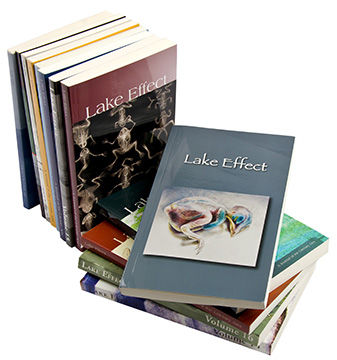Creative Writing Program Celebrates 20 Years
Behrend’s Bachelor of Fine Arts in Creative Writing program began in the fall of 2004. It was developed by George Looney, Distinguished Professor of Creative Writing and English; Dr. Jack Burke, former chancellor; and Dr. Archie K. Loss, professor emeritus of English and American studies and former director of the School of Humanities and Social Sciences.
It began, as all good stories do, with a blank page, and a question: Could Penn State Behrend, a college known for its STEM programs, become a launchpad for literary careers?
In 2004, a group of faculty members and administrators believed the answer was yes. That fall, they launched the college’s Bachelor of Fine Arts in Creative Writing, making Behrend the only Penn State campus to offer the degree.
Now, more than twenty years later, the program, still the only one at Penn State, continues to turn blank pages into books—and students into authors.
The Art of Developing Voice
Every student who graduates from Behrend’s Creative Writing program writes a book as their senior thesis. The books are bound and shelved at Lilley Library. But Dr. Tom Noyes, professor of English and creative writing, said the true measure of success is not just the physical manifestation of a volume of written work, but whether the author has a unique style.
“There is a lot of modeling as a young writer,” Noyes said. “They emulate the authors that they read and respect. But, by the time they graduate, we want them to have developed their own individual vision and voice, and the confidence to use it.”
They accomplish this the only way any writer ever does—putting a lot of words on paper.
“You have to be willing to write badly to write well,” Noyes said. “It’s a process.”
Learning By Doing
Reading, critiquing, and evaluating one another’s work is another important part of that process.
Behrend students have the chance to take this to a higher level by helping curate content for Lake Effect, the college’s international literary journal, which features works of fiction, creative nonfiction, and poetry by established and emerging writers.
As part of a class, students and faculty members read submissions and rate how well they might fit in the journal. That often leads to discussions about the structure and voice in individual pieces and the overall effectiveness of the writing.
The journal is published by the School of Humanities and Social Sciences and is supported by an endowment created by the family of Helen Thomas Kennedy. George Looney, Distinguished Professor of Creative Writing and English, and Aimee Pogson, an associate teaching professor of creative writing and English, serve as the journal’s editors. A new edition is published every spring. This year’s edition marks the twenty-ninth volume.
Stories Matter, No Matter the Field
While many Creative Writing alumni have gone on to be novelists, poets, screenwriters, teachers, journalists, and editors, others are working in less-traditional places, such as law offices, environmental agencies, historical societies and museums, and in the gaming industry.
“We’ve had some Creative Writing majors get a minor in Game Development because they want to write narratives for video games,” Noyes said.
While the tools may change and the job titles may evolve, Behrend’s Creative Writing program remains grounded in the same simple but radical idea: Stories matter.
